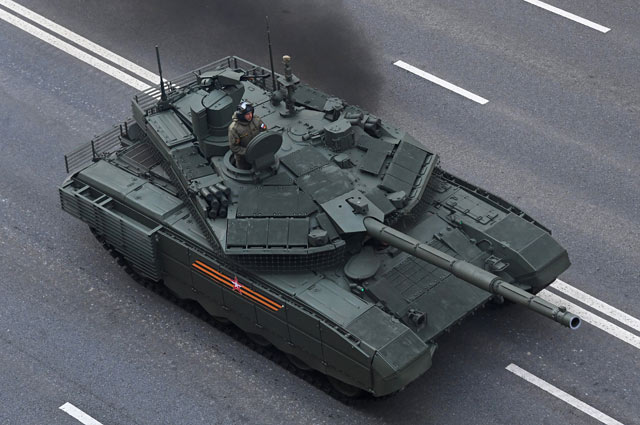
T-90M - a new tank of the Russian army
The new version of the "ninetieth" - T-90M - looks very impressive from the front. Highly visible modules of dynamic protection "Rielikt" and heads of observation and aiming devices of the fire control system "Kalina".
On September 9, on the eve of the Day of the tanker, the first public demonstration of the new version of the T-90 MBT took place at the Luga training ground near St. Petersburg. The first machine of the modernized machine, designated T-90M, took part in one of the episodes of the Zapad-2017 exercises. In the near future, such vehicles in greater numbers should enter the combat units of the Ground Forces of the Armed Forces of the Russian Federation.
A little earlier, in the last week of August, during the Moscow forum "Army-2017" (see WiT 10/2017), the Russian Ministry of Defense signed several contracts with the tank manufacturer - Uralvagonzavod Corporation (UVZ). According to one of them, the Ground Forces of the Armed Forces of the Russian Federation should receive the number of vehicles that allows to equip an armored division, and deliveries should begin next year. The order for the T-90M is the next step in a consistently implemented modernization program for Russian tanks that have been in service for many years, symbolized by the massive upgrade of T-72B vehicles to B3 standard (see WiT 8/2017), although in this case it is most likely a purchase brand new cars. At the beginning of the year, information appeared about plans to modernize all T-90 tanks in service with the Polish Armed Forces to a new model, i.e. about 400 cars. It is also possible to produce new cars.
The new tank was created as part of a research project codenamed "Prrany-3" and is a development option for the T-90/T-90A. The most important assumption was to significantly improve the main parameters that determine the combat value of the tank, i.e., firepower, survivability and traction characteristics. The electronic equipment had to be able to work in a network-centric environment and take advantage of the rapid exchange of tactical information.
The first image of the T-90M was revealed in January 2017. It confirmed that the tank is very close to the T-90AM (export designation T-90MS), developed as part of the Pripy-2 project at the end of the first decade of the 90th century. However, if this machine, due to the disinterest of the Russian army, was developed in an export version, then the T-XNUMXM was created for the Armed Forces of the Russian Federation. In the tank under discussion, many solutions were used that were not previously used in the "nineties", but were previously known, including with various proposals for modernization.
T-90M Anatomy and Survival
The most noticeable and important moment of modernization is the new tower. It has a welded structure and a hexagonal shape. It differs from the turret used in the T-90A/T-90S, including the system of holes for the withdrawal of sights heads, the presence of a niche and a flat rear wall instead of the previously used curved one. The rotating commander's cupola was abandoned and replaced with a permanent crown with periscopes. Attached to the rear wall of the tower is a large container containing, among other things, a part of the fire department.
Since the disclosure of the first information about the Pripy-3 project, there have been suggestions that the T-90M will receive a new Malachite rocket shield. The photographs of the finished tank show that it was nevertheless decided to use the Rielikt armor. In the frontal zone, extending approximately 35° to the left and right of the longitudinal plane of the turret, the main armor of the tank is covered by heavy Rielikt modules. Cassettes were also located on the surface of the ceiling. Inside are reactive elements 2S23. In addition, box-shaped modules containing 2C24 inserts were suspended from the side walls of the tower, in a zone protected by relatively thin steel plates. A similar solution was recently introduced on the latest version of the T-73B3. The modules are covered by a lightweight sheet metal casing.
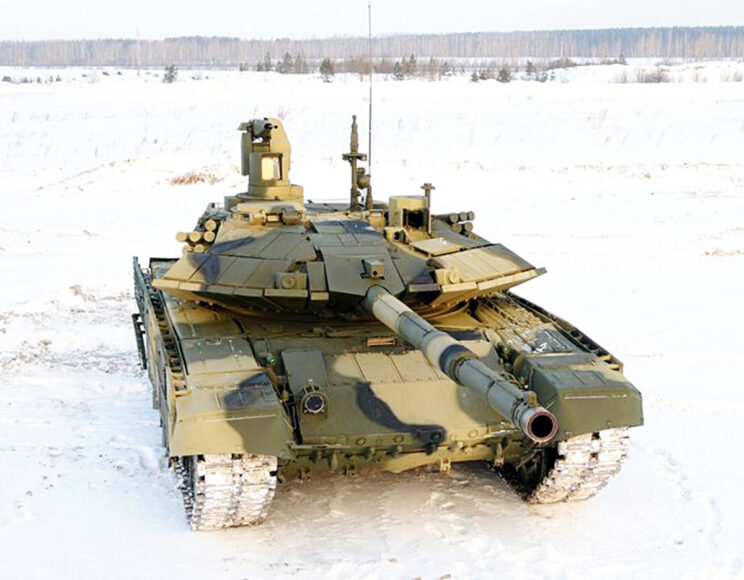
T-90AM (MS) in 2011 configuration. The 7,62 mm remote-controlled firing position is clearly visible on the turret. Despite the performance, significantly superior to the T-90 / T-90A, the Armed Forces of the Russian Federation did not dare to purchase modernized tanks based on the results of the Pripy-2 program. However, the T-90MS remained in the export offer.
Rielikt cells are identical in size to their Kontakt-5 predecessor, but use a different explosive composition. The main difference lies in the use of new heavy cartridges, moved away from the main armor. Their outer walls are made of steel sheets approximately 20 mm thick. Due to the distance between the cassette and the armor of the tank, both plates act on the penetrator, and not - as in the case of "Contact-5" - only the outer wall. The inner plate, after the cell is blown up, moving towards the ship, presses on the penetrator or the cumulative jet longer. At the same time, due to the asymmetry of the funneling process in strongly inclined sheets, the less perturbed edge of the bullet acts on the projectile. It is estimated that "Rielikt" halves the penetrating power of modern penetrators and is therefore two and a half times more effective than "Contact-5". The design of the cassettes and the cells themselves is also designed to provide protection against tandem explosive heads.
Modules with 2C24 cells are designed to protect against cumulative heads. In addition to reactive inserts, they contain steel and plastic gaskets designed to ensure long-term interaction of armor elements with the flow penetrating the cartridge.
The second important feature of Rielikt is its modularity. Dividing the lid into quick-change sections makes it easy to repair in the field. This is especially noticeable in the case of the front fuselage skin. Instead of the characteristic 5 contact-laminate chambers closed with screw caps, modules applied to the armor surface were used. Rielikt also protects the sides of the fuselage at the height of the control compartment and the fighting compartment. The bottom of the aprons are reinforced rubber sheets that partially cover the load wheels and limit the rise of dust while driving.
The sides and stern of the control compartment, as well as the container at the rear of the tower, were covered with lattice screens. This simple type of armor is about 50-60% effective against single-stage HEAT warheads of anti-tank grenade launchers.
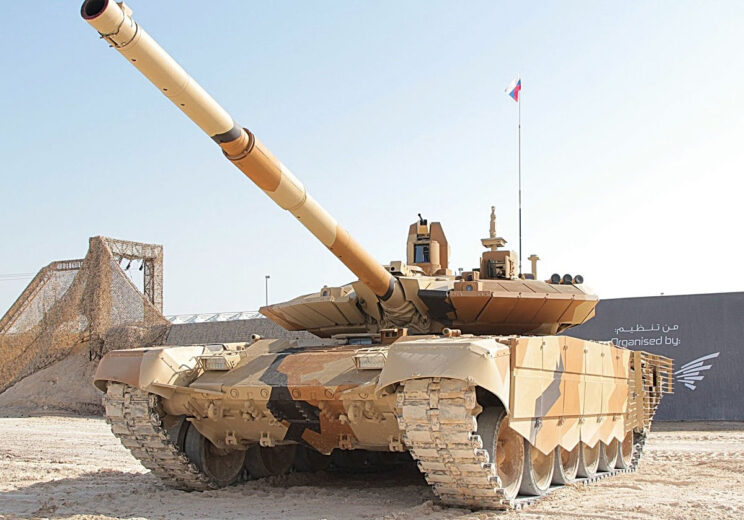
T-90MS at IDEX 2013 in Abu Dhabi, United Arab Emirates. In addition to the desert paint job, the tank also received new headlights and additional cameras for the driver.
In the first image of the T-90M, lattice screens protected the base of the turret from the front and sides. On the car introduced in September, the covers were replaced with a relatively flexible mesh. The source of inspiration, without a shadow of a doubt, is the solution developed by the British concern QinetiQ, now known as Q-net, (aka RPGNet), used, among other things, on Polish wolverines during the operation in Afghanistan. The sheath consists of short lengths of tensile cable tied into a mesh with massive steel knots. The latter elements also play an important role in damaging HEAT projectile warheads. The advantage of the grid is its low weight, up to two times less than that of tape screens, as well as ease of repair. The use of a flexible boot also makes it easier for the driver to get on and off. The effectiveness of the network against simple HEAT weapons is estimated at 50-60%.
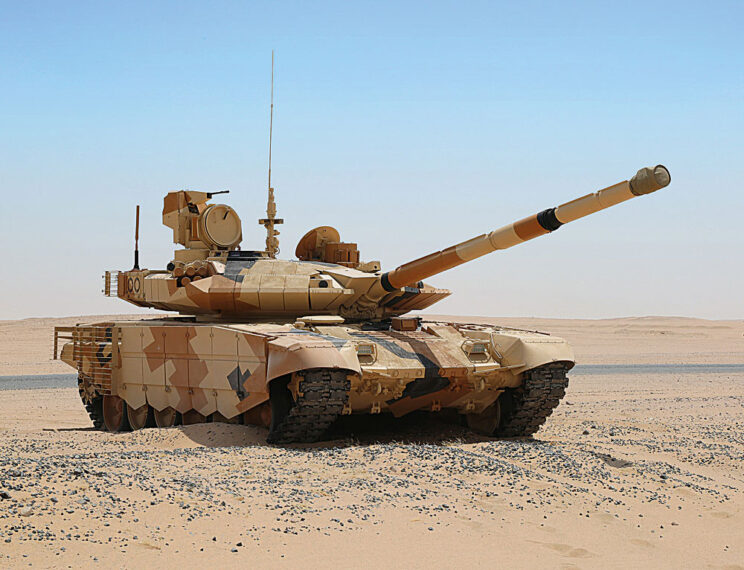
The T-90MS aroused the interest of several potential users. In 2015, the machine was field tested in Kuwait. According to media reports, the country wanted to purchase 146 T-90MS vehicles.
Probably, as in the case of the T-90MS, the inside of the combat and steering compartments was lined with an anti-fragmentation layer. Mats reduce the risk of injury to crew members on non-penetrated hits and reduce damage after armor penetration. The sides and top of the carousel carrier of the cannon loading system were also covered with protective material.
The tank commander received a new fixed position instead of a rotating turret. The design of the hatch allows you to fix it in a partially open position. In this case, the commander can observe the environment through the edge of the hatch, covering his head with a lid from above.
Rumors about the use of the modern Afghanit self-defense system in the T-90M turned out to be untrue, as was the case with the Malachite armor. A variant of the Sztora system, designated TSZU-1-2M, was installed on the vehicle introduced in September. It includes, among other things, four laser radiation detectors located on the tower, and a control panel at the commander's post. When a threat is detected, the system can automatically fire smoke and aerosol grenades (compared to the T-90MS, the layout of their launchers has been slightly changed). Unlike previous versions of the Sztora, the TSZU-1-2M did not use infrared heaters. Of course, it cannot be ruled out that in the future the T-90M will receive a more advanced self-defense system. However, the use of the Afganit, with its extensive threat detection systems and smoke grenade and anti-missile launchers, would require significant changes in the configuration of the turret equipment and, of course, could not be overlooked by observers.
For the T-90MS, a camouflage package was developed, which was a combination of Nakidka and Tiernownik materials. It can also be used on the T-90M. The package serves as a deformation camouflage in the visible spectrum and limits the visibility in the radar and thermal ranges of the tank equipped with it. The coating also reduces the rate at which the vehicle's interior heats up from the sun's rays, offloading the cooling and air conditioning systems.
weaponry
The main armament of the T-90M is a 125 mm smoothbore gun. While the most advanced versions of the "nineties" have so far received guns in the 2A46M-5 variant, in the case of the latest upgrade, the 2A46M-6 variant is mentioned. Official data on 2A46M-6 has not yet been made public. The subsequent number in the index indicates that some modifications were made, but it is not known whether they led to an improvement in some parameters or whether they had a technological basis.
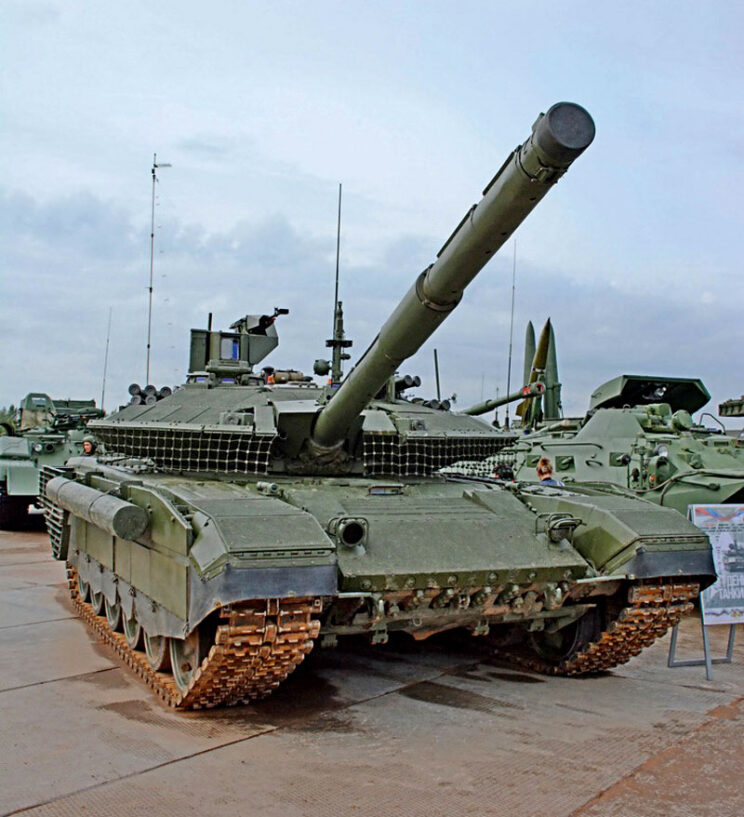
T-90M during a demonstration at the Luga training ground - with a mesh screen and a new 12,7-mm GWM station.
The weight of the gun is about 2,5 tons, of which less than half falls on the barrel. Its length is 6000 mm, which corresponds to 48 calibers. The barrel cable is smooth-walled and chrome-plated for longer life. The bayonet connection makes it relatively easy to replace the barrel, including in the field. The barrel is covered with a heat-insulating casing, which reduces the effect of temperature on shooting accuracy, and is also equipped with a self-blower.
The gun received a system that controls the deflection of the barrel. It consists of a light beam emitter with a sensor located near the gun casing and a mirror installed near the muzzle of the barrel. The device takes measurements and sends the data to the fire control system, which makes it possible to take into account the dynamic vibrations of the barrel in the process of adjusting the ballistic computer.
When the first, scarce information about the T-90M appeared, it was assumed that the tank would be armed with one of the variants of the 2A82-1M gun, which is the main armament of the T-14 Armata vehicles. A completely new design, with a barrel length of 56 calibers (which is a meter more than the 2A46M). By increasing the allowable pressure in the chamber, the 2A82 can fire more powerful ammunition, and should also be clearly more accurate than its predecessors. Photos of the T-90M from September this year. however, they do not support the use of any of the 2A82 variants.
The gun is driven by a loading mechanism belonging to the AZ-185 series. The system has been adapted to use long-penetrating sub-caliber ammunition such as the Swiniec-1 and Swiniec-2. Ammunition is defined as 43 rounds. This means that in addition to 22 shots in the carousel and 10 in the turret niche, 11 shots were placed inside the fighting compartment.
So far, there is no information about the devices responsible for stabilizing and guiding the main armament. In the case of the T-90MS, the latest version of the proven 2E42 system was used, with an electro-hydraulic gun lifting mechanism. Russia has also developed a fully electric system 2E58. It is characterized, including lower power consumption, increased reliability and increased accuracy compared to previous solutions. An important advantage is also the elimination of the hydraulic system, which is potentially dangerous for the crew in case of damage after breaking through the armor. Therefore, it cannot be ruled out that 90E2 was used in the T-58M.
Auxiliary armament consists of: 7,62 mm machine gun 6P7K (PKTM) and 12,7 mm machine gun 6P49MT (Kord MT). The first is connected to the cannon. The stock of 7,62 × 54R mm cartridges is 1250 rounds.

New armor and a cellar at the rear of the turret changed the silhouette of the upgraded Ninety. On the side there is a characteristic beam for self-pulling out the car in case of getting stuck in a swampy area.
After the disclosure of the T-90MS, a lot of controversy was caused by its arming with a second PKTM, installed on a remotely controlled firing position T05BV-1. The main point of criticism was the low usefulness of these weapons against armored targets such as light combat vehicles and attack helicopters. Therefore, the T-90M decided to return to the MG. The 12,7-mm Kord MT rifle was placed on a remote-controlled post on the tank turret. Its pedestal was installed coaxially around the base of the commander's panoramic instrument. Compared to the T05BW-1, the new mount is asymmetrical, with the rifle on the left and the ammo rack on the right. The commander's seat and the device are not mechanically connected and can be rotated independently of each other. After the commander selects the appropriate mode, the station follows the line of sight of the panoramic device. The firing angles are likely to have remained unchanged compared to the module with the T-90MS and range from -10° to 45° vertically and 316° horizontally. The stock of cartridges of 12,7 mm caliber is 300 rounds.
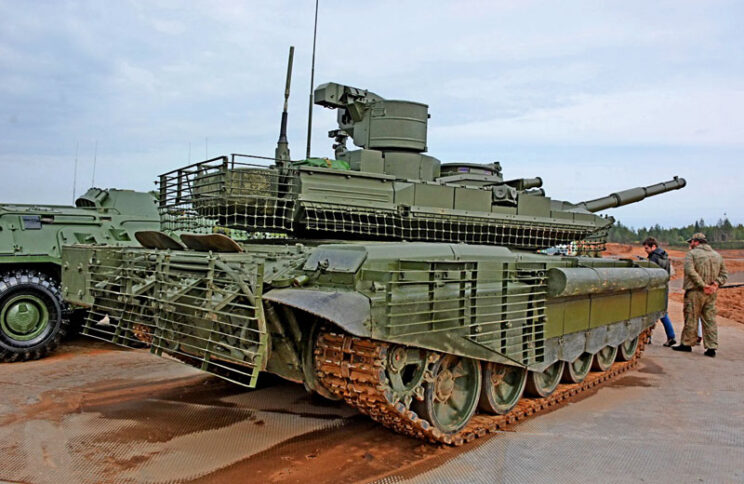
The experience of recent conflicts shows that even older HEAT shells can pose a threat to modern tanks when they enter less protected areas. The armor of the crate increases the likelihood that the vehicle will not receive more serious damage in the event of such hits.
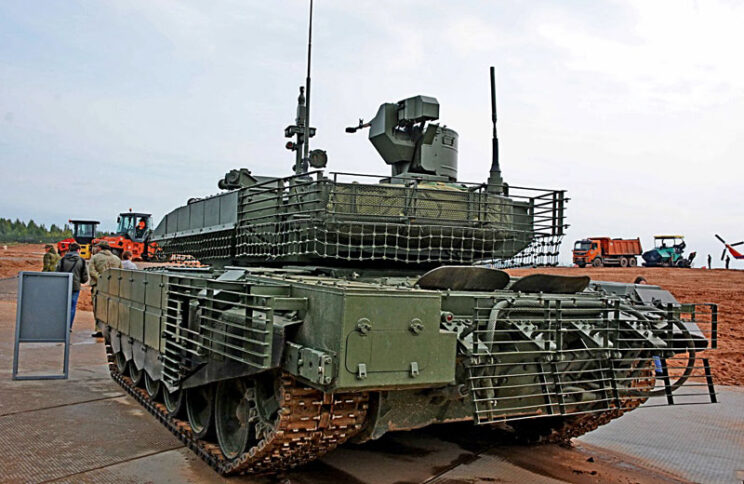
The bar screen also covers the outlet. The armored hull of the auxiliary power generator is visible in the rear of the hull.
Fire control system and situational awareness
One of the most important changes made during the modernization of the "ninetieth" is the complete abandonment of the previously used fire control system 1A45T "Irtysh". Despite decent parameters and functionality, today Irtysh belongs to outdated solutions. This applies, among other things, to the division into day and night gunner's instruments and the hybrid architecture of the entire system. The first of the aforementioned solutions has been considered unergonomic and inefficient for years. In turn, the mixed structure of the system reduces its susceptibility to change. Although the ballistic computer is a digital device, its relationship with other elements is similar. This means that, for example, the introduction of a new design of ammunition with new ballistic properties requires hardware modification at the system level. In the case of the Irtysh, three more variants of the 1W216 block were introduced, modulating the analog signals coming from the ballistic computer to the weapon guidance system, in accordance with the selected type of cartridge.
The modern DKO Kalina was used in the T-90M. It features an open architecture, and its heart is a digital ballistic computer that processes data from sensors, sights and turret crew consoles. The complex includes an automatic target tracking system. The connections between the individual elements of the system are made via a digital bus. This facilitates the possible expansion and replacement of modules, the implementation of software updates, and simplifies diagnostics. It also provides integration with the tank's electronics system (so-called vector electronics).
The gunner of the tank has a multi-channel sight PNM-T "Sosna-U" of the Belarusian company JSC "Pieleng". Unlike the T-72B3, in which this device was used instead of a night sight, on the left side of the turret, the T-90M has the device located almost directly in front of the tanker's seat. This makes the gunner's position much more ergonomic. The Sosna-U optical system implements two magnifications, ×4 and ×12, at which the field of view is 12° and 4°, respectively. The night channel uses a thermal imaging camera. Thales Catherine-FC devices of this type have been installed in Russian tanks so far, but it is also possible to use the more modern Catherine-XP camera. Both cameras operate in the range of 8-12 microns - long-wave infrared radiation (LWIR). The less advanced model uses a 288x4 detector array, while the Catherine-XP uses 384x288. Large sensor sizes and sensitivity lead, in particular, to an increase in the detection range of the target and an improvement in image quality, which facilitates identification. Both camera schemes provide two magnifications - × 3 and × 12 (field of view 9 × 6,75° and 3 × 2,35°, respectively) and have a digital zoom that allows observation with a magnification × 24 (field of view 1,5 × 1,12 ,XNUMX°). The image from the night channel is displayed on the monitor at the gunner's place, and from the daytime it is visible through the eyepiece of the sight.
A pulsed laser rangefinder is built into the Sosny-U case. A neodymium yellow crystal emitter delivers a 1,064 µm beam. Measurement is possible at a distance of 50 to 7500 m with an accuracy of ±10 m. In addition, the Riflex-M missile guidance unit is integrated with the sight. This module includes a semiconductor laser that generates a continuous wave.
The input mirror of the device is stabilized in both planes. The average stabilization error is determined to be 0,1 mrad when moving at speeds up to 30 km/h. The design of the sight allows you to change the position of the aiming line in the range from -10° to 20° vertically and 7,5° horizontally without the need to rotate the tower. This ensures high tracking accuracy of a moving target in relation to the vehicle accompanying it.
In addition to Sosna-U, the PDT sight was installed on the T-90M. It acts as an auxiliary or emergency device. PDT was installed between the main sight and the gun, the periscope head was brought out through a hole in the roof. The housing contains day and night cameras using a residual light amplifier. The television picture can be displayed on the gunner's monitor. The PDT field of view is 4×2,55°. The grid is created by the projection system. The grid, in addition to the stop mark, includes two scales that allow you to determine the distance to the target at its own height of 2,37 m (for a gun) and 1,5 m (for a coaxial machine gun). After measuring the distance, the gunner sets the distance using the remote, which adjusts the position of the reticle according to the type of ammunition selected.
The viewfinder entrance mirror is mechanically connected to the cradle using a system of levers. The range of vertical movement of the mirror is from −9° to 17°. The line of sight stabilizes depending on the weapon, the average stabilization error does not exceed 1 mrad. The PDT is equipped with its own power supply, providing 40 minutes of operation.
The covers of the Sosna-U and PDT heads protruding above the ceiling level are equipped with movable covers controlled remotely and protecting the lenses of the devices. This is a notable novelty in the case of Russian cars. On earlier tanks, the sight lenses were either unprotected or the covers were screwed on.
In the T-90M, as in the case of the T-90MS, they abandoned the partially rotating commander's cupola. In return, he was given a stationary position, surrounded by a wreath of eight periscopes, as well as a panoramic observation and sighting device of the Polish Academy of Sciences "Falcon's Eye". Under each of the periscopes there is a call button. Clicking on it causes the panoramic sight to rotate to the corresponding sector of observation.
Behind the commander's hatch was placed "Falcon's eye", similar to the Belarusian "Pine-U". Two cameras are installed in the common body, day and thermal imaging, as well as a laser rangefinder. In day mode, the unit performs x3,6 and x12 magnification. The field of view is 7,4×5,6° and 2,5×1,9°, respectively. The night track is based on the Catherine-FC or XP camera. The laser rangefinder has the same characteristics as those used in Sosno. The cylindrical body of the sight can be rotated through a full angle; The vertical range of movement of the entrance mirror is from -10° to 45°. The aiming line is stabilized in both planes, the average stabilization error does not exceed 0,1 mrad.
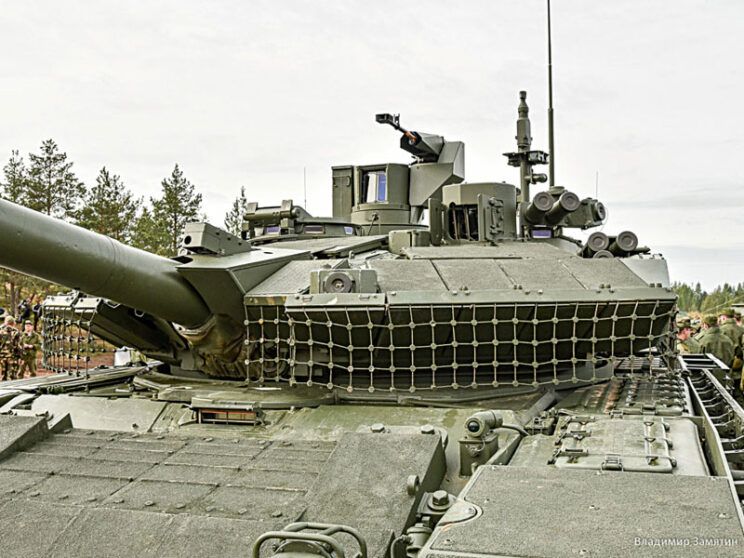
Close-up of the T-90M turret. The open covers of the optics of the commander's and gunner's observation and aiming devices, as well as the laser radiation sensor and smoke grenade launchers are clearly visible. A mesh screen has the same efficiency as a rod or rod cover but is much lighter. Moreover, it does not prevent the driver from taking his place.
Images from the cameras of the panoramic device are displayed on the commander's monitor. Kalina's DCO configuration gives him access to almost all system functions. If necessary, he can take control of weapons and use Hawkeye, Sosny-U night channel or PDT for guidance. In the basic mode of interaction with the gunner, the task of the commander is to detect targets and indicate them with a panoramic device according to the "hunter-killer" principle.
As already mentioned, Kalina SKO was associated with other T-90M electronic systems, i.e. control, navigation and communication system. The integration provides a two-way automated flow of information between the tank and the command post. These data concern, among other things, the position of own forces and the detected enemy, the condition and availability of ammunition or fuel, as well as orders and calls for support. The solutions allow the tank commander, among other things, the operational aiming of sights at the appropriate area of the terrain, using the dashboard of a multi-tasking command support system with a map display.
The situational awareness of the commander is enhanced by the use of an additional surveillance system introduced a few years ago on the T-90MS. It consists of four chambers. Three of them were located on the mast of the weather sensor, placed on the ceiling of the tower behind the gunner's hatch, and the fourth was located on the right wall of the tower. Each camera has a field of view of 95×40°. The built-in residual light amplifier allows you to observe in low light conditions.
Compared to the rich optoelectronic equipment of the tower, the observation devices of the T-90M driver are relatively poor. The demonstrated tank did not receive an additional day / night surveillance system, known from one of the "exhibition" mutations of the T-90AM / MS. Instead of futuristic LED lighting, the tandem of visible light FG-127 and infrared light FG-125, well-known for several decades, is installed in the front of the fuselage. The use of a separate rear view camera has also not been confirmed. Its function, however, to some extent can be performed by the cameras of the surveillance system on the tower.
So far, no details about the topographic connection and communication systems are known. However, it is likely that the T-90M received a similar kit to the T-90MS, allowing it to take advantage of digital vectronics and a fire control system. The package includes a hybrid navigation system with inertial and satellite modules. In turn, external communication is based on the radio systems of the Akwieduk system, which are also installed, including in T-72B3 tanks.

Single vehicles, probably prototypes, T-90M and T-80BVM took part in the Zapad-2017 exercises.
Traction characteristics
As for the T-90M drive, the most important change compared to the previous versions of the "ninetieth" is the use of a new "driver" control system. The double levers that had been used on Soviet and Russian tanks for years were replaced by a shuttlecock steering wheel. Gear ratios change automatically, although manual override is also retained. Modifications make it easier to control the tank. Thanks to the relief of the driver, the average speed and its dynamics also increased slightly. However, no mention is made of eliminating a significant disadvantage of the gearboxes used so far, namely the only reverse gear that allows only slow reverse.
Probably, the T-90M received the same power plant as the T-72B3. This is a W-92S2F (formerly known as W-93) diesel engine. Compared to the W-92S2, the power output of the heavy variant has increased from 736 kW/1000 hp. up to 831 kW/1130 hp and torque from 3920 to 4521 Nm. Design changes include the use of new pumps and nozzles, reinforced connecting rods and crankshaft. The cooling system and filters in the intake system have also been changed.
The combat weight of the modernized "ninety" is determined at 46,5 tons. This is one and a half tons less than that of the T-90AM / MS. If this figure is correct, then the specific weighting factor is 17,9 kW/t (24,3 hp/t).
The powerplant of the T-90M is derived directly from solutions developed for the T-72, therefore it is not quick-change. Today this is a big drawback. Repair takes a long time in case of engine or transmission failure.
The need for electricity when the engine is off is provided by an auxiliary power generator. Like the T-90MS, it is installed in the rear fuselage, on the left track shelf. This is probably a chip marked DGU7-P27,5WM1 with a power of 7 kW.
Due to the increased weight of the tank compared to the T-90A, the suspension on the T-90M was most likely reinforced. In the case of the very similar T-90MS, the changes were to use new road wheels with bearings and hydraulic shock absorbers. A new caterpillar pattern was also introduced, unified with the Armata tank. If necessary, the links can be fitted with rubber caps to reduce noise and vibration when driving on hard surfaces, as well as to limit damage to the road.

Rear view of the T-90M during a demonstration to Russian President Vladimir Putin at the Luga training ground.
Summation
The development of the T-90M is the next stage of a long-term program for the modernization of the armored forces of Russia. Its significance is confirmed by recently published reports of a reduction in orders for new generation T-14 Armata vehicles and plans to focus on the modernization of older tanks already in the lineup dating back to the Soviet Union.
It is still unclear whether the contract with UVZ concerns the reconstruction of the "nineties" in service or the construction of completely new ones. The first option is suggested by previous reports. Basically, it consists in replacing the T-90 / T-90A towers with new ones, and the meaning of this is doubtful. Although some solutions are already obsolete, replacement of the original turrets is not required in a short time. However, it cannot be completely ruled out. The modernization of a number of T-80BV tanks a few years ago can serve as a precedent. T-80UD towers were installed on the hulls of these machines (considered unpromising due to the use of non-Russian-made 6TD series diesel engines). Such modernized tanks were put into service under the designation T-80UE-1.
Over the course of several years, the Armed Forces of the Russian Federation have not only been modernized, but also expanded. In the context of the development of the structures of the armored forces and the announcement of limiting orders for the Armata, the production of completely new T-90Ms seems very likely.
T-80BWM
At the same exhibition as the T-90M, the T-80BVM was also presented for the first time. This is the latest idea for the modernization of the most serial versions of the "eighties" that are at the disposal of the armored forces of Russia. Previous modifications of the T-80B / BV, i.e. T-80BA and T-80UE-1 vehicles entered service in limited quantities. The development of the T-80BVM complex and the contracts already signed prove that the Armed Forces of the Russian Federation do not intend to abandon vehicles of this family. According to the announcements, the upgraded tanks will first go to the 4th Guards Kantemirovskaya Tank Division, using the "XNUMX", also in the UD variant.
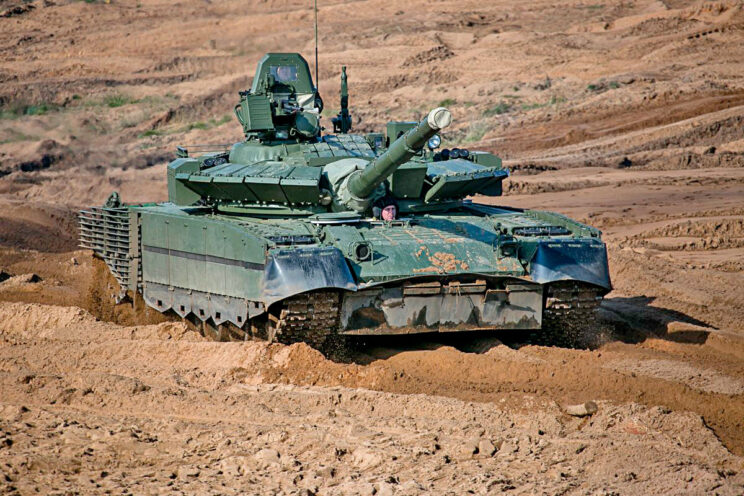
T-80BVM during the demonstration accompanying the Zapad-2017 exercise. A reinforced rubber screen is suspended in the forward part of the fuselage, similar to the solution used in the Polish PT-91.
The modernization of several hundred (probably at the first stage of the 300 program) T-80B / BV was announced at the end of last year. The main provisions of these works are to bring to the level
mu is similar to T-72B3. In order to increase the level of protection, the main armor of the T-80BVM was equipped with Rielikt rocket shield modules in versions 2S23 and 2S24. The tank also received stripe screens. They are located on the sides and rear of the drive compartment and also protect the rear of the turret.
The main armament of the tank is a 125 mm 2A46M-1 gun. No information has yet been received about plans to arm the T-80BVM with more modern 2A46M-4 guns, which are an analogue of the 2A46M-5, adapted to work with the "eighty" loading system.
The vehicle can fire Riefleks guided missiles. The loading mechanism is adapted for modern sub-caliber ammunition with an extended penetrator.
The original T-80B/BVs were equipped with the 1A33 fire control system and the 9K112 Kobra guided weapon system. These solutions represented the state of the art of the 70s and are now considered completely obsolete. An additional difficulty was the maintenance of devices that had not been produced for a long time. Therefore, it was decided that the T-80BVM will receive the Kalina SKO variant. As in the T-90M, the gunner has a Sosna-U sight and an auxiliary PDT. Interestingly, unlike the T-90M, the lens bodies are not equipped with remote covers.

T-80BVM turret with clearly visible Sosna-U and PDT heads. One of Rielikt's tapes draws attention. This arrangement should facilitate the landing and disembarkation of the driver.
Like the T-72B3, the commander's position was left with a rotating turret and a relatively simple TNK-3M device. This limits the commander's ability to observe the environment,
However, it is definitely much cheaper than installing a panoramic viewfinder.
One of the necessary conditions for modernization was the replacement of communications. Most likely, as in the case of the T-72B3, the modernized "eighty" received radio stations of the "Akviduk" system.
It is reported that the upgraded tanks will receive turboshaft engines in the GTD-1250TF variant, which will replace the earlier GTD-1000TF variant. Power increased from 809 kW/1100 hp up to 920 kW/1250 hp It is mentioned that the operating mode of the engine has been introduced, in which it is used exclusively to drive an electric generator. This is necessary to limit the greatest weakness of the turbine drive, i.e. high fuel consumption during idle.
According to official information, the combat weight of the T-80BVM has increased to 46 tons, i.e. reached the level of T-80U / UD. The power factor of the unit in this case is 20 kW/t (27,2 hp/t). Thanks to the turbine drive, the T-80BVM still retains a clear advantage in terms of traction characteristics over the modernized T-90.